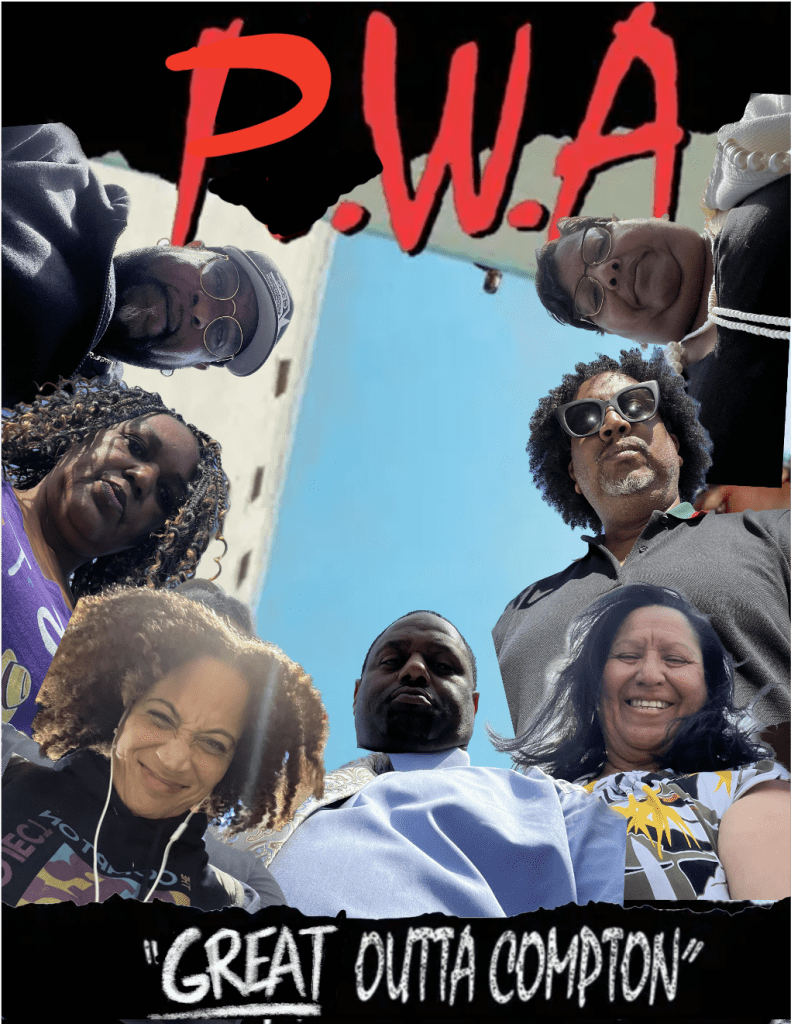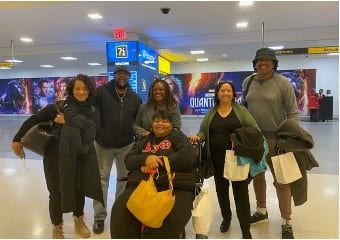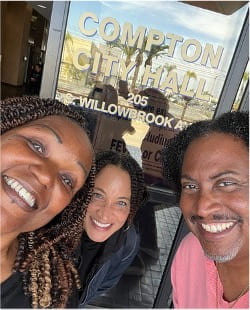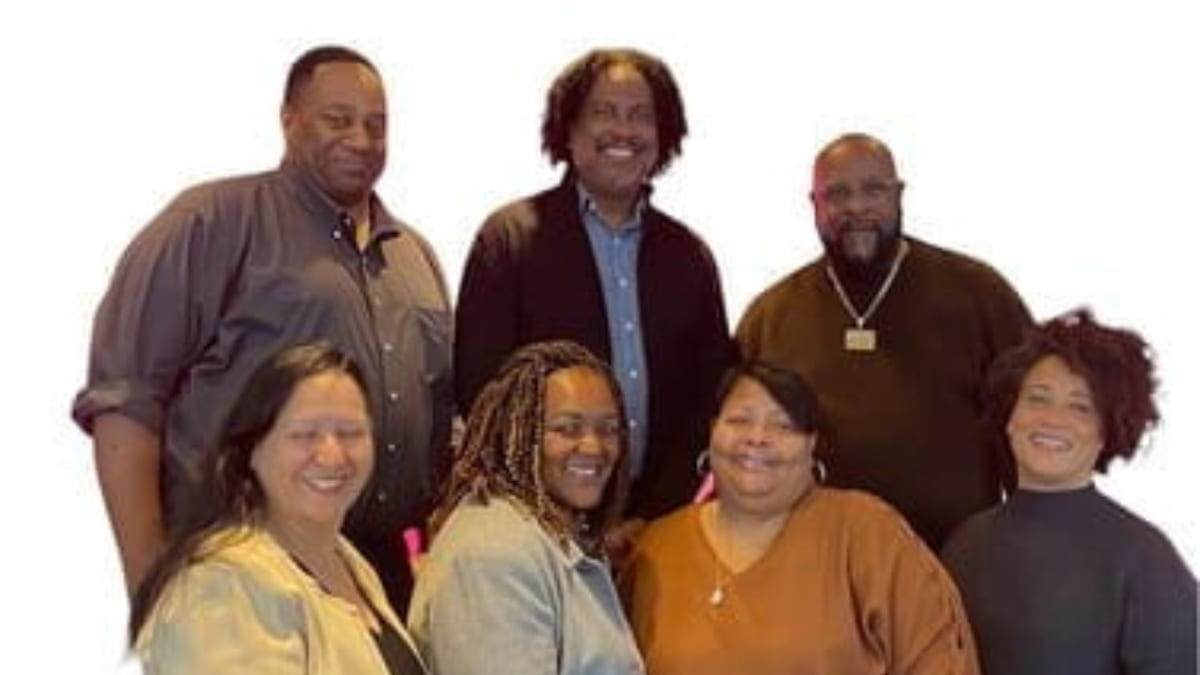Guest blog by Karen Harris, Rosalind McGary, La Shawn Kindle-Young, Jimmie Smith, John D. Strickland Jr, Maria Villareal, Alonzo Williams

The Great Outta Compton team was officially established in January 2023 by Mayor Emma Sharif to tackle some of the problems facing our community. The team consists of community stakeholders, and city staff; each of them have committed themselves to the betterment of the Compton community.
On February 11-17, 2023, the team participated in the Bloomberg Harvard City Leadership Initiative Cross-Boundary Collaboration Track sessions in New York City, New York. This was an intense leadership development session for ten city teams worldwide.
The Great “Outta” Compton team began its mission of refining our problem statement. We struggled with working together as a newly developed group and trying to adapt and integrate our hectic schedules into our newfound assignment. We initially started out by identifying our problem statement to be the City’s public spaces and infrastructure is deteriorating leading to issues directly affecting the physical and emotional well-being and health of the City of Compton residents.
We then asked ourselves
- Why does it matter? Because the City’s public spaces and infrastructure impact the health, safety, and well-being of its residents.
- Why does it matter? It matters how others view the City.
- Why does it matter? It would change the image of the City to encourage more people to stay, work and invest in the city.
- To whom does it matter? It matters to everyone that lives, works, and grows up here, as they are impacted by the conditions of our public spaces and infrastructure.
- Who needs to care more and why? The residents, business owners, political leaders, school district, County, and State officials.
- How would you get them to give it more attention? We would point out the consequences of not addressing the issues which include failed streets, safety issues, lawsuits, homelessness, loss of revenue, increase in crime, and unsafe health conditions.
- What would the problem look like when it is solved? The City of Compton will have clean paved streets, renovated buildings, clean water, affordable housing, anchored communities, more development, an increase in investors, an increase in revenue, more visitors, and an increase in population. Overall, a better quality of life.
In speaking with stakeholders, street improvements constantly came up as a main concern in the community. Some didn’t believe the efforts that City staff had made were enough. There were constant debates within the team on whether street improvements had been consistently implemented throughout the City. There appeared to be a disconnect between what was happening in city hall and what the stakeholders saw. This was the central focus of our debate. Thus, after weeks of iteration, the team decided that our problem statement should include the lack of civic engagement and trust as it relates to street improvements.

After several team meetings, we were able to develop six causes and sub causes related to our problem statement: Lack of Public Safety, Lack of Staff, Redlining, Lack of Funding, Lack of Civic Involvement, and Aging Infrastructure. After several iteration exercises, we located where we had the authority and entry point to tackle a portion of the larger issue. The team was then able to solidify its problem statement to read “We will tackle the lack of civic engagement and trust related to street improvements because the citizens of Compton deserve safe navigable streets“.
We learned:
- the importance of identifying a problem that people uniquely share and the value of developing a problem statement that clearly states the challenges in front of you.
- it is important to have a champion that will advocate for you while you work to solve your problem.
- problems need to be deconstructed in order to identify entry points that you can utilize to begin to tackle them. These issues have causes and sub- causes that should be broken down to obtain Authority, Acceptance, and Ability.
- the importance of having small wins in problem solving. Thus, solving problems incrementally can build momentum needed to solve complex problems over time through the process of iteration.



Progress and Insights
Since the inception of our program the team has made great strides. We have developed our own group Facebook page, providing updated information regarding street improvements. We have engaged with the community through our participation in a group podcast. We have participated in presenting to the community our priority projects through the budget process. We are advocating for an arts district. We have engaged with our block clubs and have a representative of our team as a major advocate for civic engagement and building trust. Three of our team members are on the Parks and Recreation Commission and the Beautification Commission. The team was instrumental in developing the City’s Capital Improvement Plan. The team has been a part of the hiring of additional staff in the Public Works Department.
The team was directly involved in the construction of three street reconstruction projects. The team lead the charge in civic engagement and meeting with homeowners to increase transparency in communicating the progress of our street improvement projects. The team continues to build trust and communication with our block clubs, elected officials, school board, college board representatives, small businesses, and community. We continue to be asked to participate in various problem solving sessions by community members. Our team has received special recognition from our Mayor and City Council for their outstanding participation is the areas of volunteering and beautification.
The tools we’ve learned through the program will forever change our view of how we approach problems in the future. Oftentimes, we are faced with very complex problems. Through this program we’ve learned to approach these issues differently, to understand the source and history and the “why” of them.
We learned to develop a problem statement to narrow down the specific problem to address. Who should care about the problem and what might we do to convince them to care. We learned the value of deconstructing the problem into various parts, causes and subcauses using the fishbone diagram.
We learned to determine the entry points by developing the change analysis to determine where we have Authority, Acceptance, and Ability (AAA). Where we have a high level of Authority, Acceptance, and Ability, we’ll know to take the necessary action to engage and iterate.
Additionally, we have learned to determine who else we need to talk with (everyone!), and who are the authorizers that we need to further iterate with. We’ve learned to continue to iterate, reflect, take action and most importantly, to celebrate small wins.
Finally, we learned the importance of building a team, scheduling regular meetings, developing our team bylaws, documenting our progress, and continuing the Problem Driven Iteration Adaption process with all stakeholders to assist us in solving complex problems.
It’s all about community!
This is part of a blog series written by city leaders who participated in the Bloomberg Harvard City Leadership Initiative cross-boundary collaboration track during 2023.
